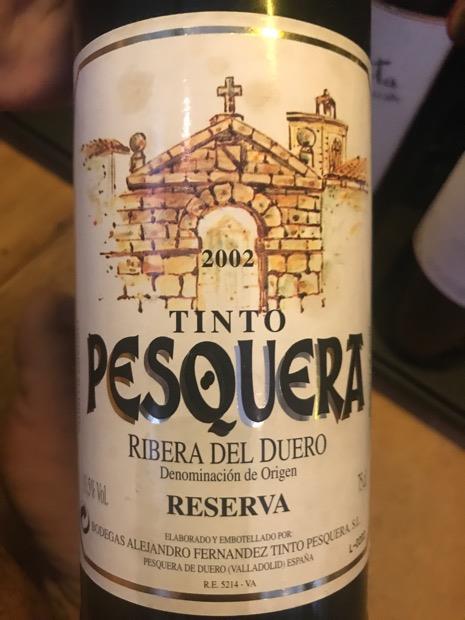
External search
Google (images)
Wine Advocate
Wine Spectator
Burghound
Wine-Searcher
Vintages
2020
2019
2018
2017
2016
2015
2014
2013
2012
2011
2010
2009
2008
2007
2006
2005
2004
2003
2002
2001
Show more
From this producer
Show all wines
All tasting notes
|
| Drinking Windows and Values |
| Community Tasting History |
| Community Tasting Notes (average 91 pts. and median of 91 pts. in 3 notes) - hiding notes with no text | | | Tasted by alion on 2/14/2009 & rated 91 points: Lovely. Creamy from oak, black fruit and spice on the finish. (4240 views) | | | Tasted by alion on 11/3/2008 & rated 91 points: Another excellent showing: needed 2 hours air to come together, then smooth and silky, black and red fruit, vanilla from the oak. Outstanding. (3969 views) | | | Tasted by alion on 12/1/2007: Great surprise. Plenty of black fruit [and some red after a couple of hours], some gentle vanilla oak, smooth, silky and warm, wonderful room filling aroma. Much better than 6 months ago. Outstanding. (4115 views) |
| By Stephen Tanzer
Vinous, September/October 2005, IWC Issue #122
(Bodegas Alejandro Fernandez Ribera del Duero Tinto Pesquera Reserva) Subscribe to see review text. |
NOTE: Scores and reviews are the property of Vinous. (manage subscription channels) |
| Bodegas Alejandro Fernández Producer website
U.S. Importer (Addt'l Info)Bodegas Alejandro Fernández Ribera del Duero Tinto Pesquera Reserva24 meses en barrica de roble americano + 12 meses en botella.Tempranillo Varietal character (Appellation America) | TAPAS: Tempranillo Advocates, Producers and Amigos Society
Tempranillo is the premium red wine grape variety from the Rioja and Ribera del Duero region in Spain. Tempranillo's aromas and flavors often combine elements of berryish fruit, herbaceousness, and an earthy-leathery minerality. Being low in acidity and sugar content, it is commonly blended with Carignan (Mazuela), Grenache (Garnacha), Graciano, Merlot and Cabernet Sauvignon.
WineAccess
The varietal is at its best in top Riojas, where oak aging is employed to generate increased complexity and harmony. From the best sites, these wines can be remarkably concentrated with great aging potential. New wines from this region are darker, and more robust, with more dynamic primary fruit flavors than traditionally styled examples. These wines seem to reflect the influence of Spain's other key region for Tempranillo, Ribera del Duero. Regardless of style, Riojas tend to be medium bodied wines, with more acid than tannins. These wines generally feature Tempranillo blended with Garancha, Mazuelo, and Graciano. For these wines, there are three quality levels, which will appear on the label. Everyday drinking wines fall under the category of "Crianza", "Reserva" denotes more complex and concentrated wines, and "Gran Reserva" refers to the most intense wines, made only in the best years.
The same labeling scheme applies to wines from Ribera del Duero, which, like Rioja, is dominated by Tempranillo and shares similar blending grapes. Again, Ribera del Duero wines are generally darker and more powerful than the most traditional Riojas. These wines also generally see less oak treatment than Riojas. From Rioja, we like wines from Allende, Marqués de Cáceres, Montecillo, and Cune. In Ribera del Duero, consider Dominio de Pingus, Emilio Moro, Convento San Francisco, and Pesquera.
Pair older-style Rioja with simple meats like chicken, leg of lamb, and pork loin. However, the newer style of Rioja and Ribera del Duero works especially well with bolder meat dishes or an aged Spanish cheese like Manchego or Idiazabal. Spain Vinos de España - Wines of Spain (Instituto Español de Comercio Exterior) | Wikipedia
Wine Map on weinlagen-info
Spain is the third largest wine producing nation in the world, occupying the majority of the Iberian Peninsula with vast diversity in climate, culture, and of course, wine. From inky, dark reds of the [Priorat] to dry, white Finos from Andalusia, Spain can easily boast of elaborating a wide variety of notable styles. Within Spain there are currently 62 demarcated wine regions, of which a handful have gained international recognition: [Rioja], Priorat and [Ribera del Duero]. Yet these regions are only a small sample of the high quality wines Spain produces. Regions such as Cava, Penedes, Somontano, Galicia, Rueda and Jerez are only a few of the numerous regions worthy of exploration throughout Spain. Spain can also lay claim to having the most land under vine in the world, growing up to, by some accounts, 600 indigenous varietals of which Tempranillo is their most well known. Other popular varietals include [Garnacha], Bobal and Monastrell for reds and for whites; the infamous [sic] Palomino Fino grape which is used in the production of sherry wine, Pedro Ximenez in Montilla Morilles, Albarino used in the creation of the bright, effervescent wines of Galicia, and Verdejo in Rueda. - Source: - Catavino.net
Spain is not in the forefront of winemaking for its dessert wines, other than for its sweet wines from Sherry country including the highly revered Olorosos (when sweetened). But apart from Sherry Spain has a range of styles of dessert wines, ranging from the those made from the Pedro Ximenez grape primarily in Jerez and Montilla-Moriles) to luscious, red dessert wines made in the Mediterranean from the Garnacha (Grenache) grape. Some good Moscatels are made in Mallorca, Alicante and Navarre. The northwest corner of Spain, Galicia, with its bitter Atlantic climate, is even making dessert wines, called “Tostadillos” in the village of Ribadivia (similar to France’s “Vin de Paille”). The Canary Islands have made interesting dessert wines for centuries (they are mentioned by Shakespeare, for example) and in recent years the quality of winemaking has been improved and the Canary Islands wines are being better marketed now. The winemaking styles for “Vinos Dulces” are also diverse, from “Late Harvest” (Vendimia Tardía) to “Fortified Wines” (Fermentación Parcial). Based on in-spain.info.Castilla y León Castilla y León Wine (Turismo Castilla y León )Ribera del Duero El Corazón del Duero - The Heart of Duero (Consejo Regulador de la D.O. Ribera del Duero) |
|




